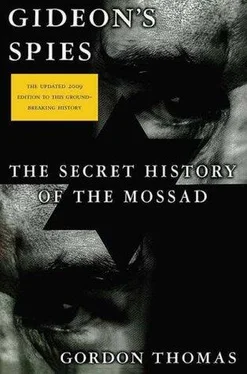Gordon Thomas - Gideon's Spies
Здесь есть возможность читать онлайн «Gordon Thomas - Gideon's Spies» весь текст электронной книги совершенно бесплатно (целиком полную версию без сокращений). В некоторых случаях можно слушать аудио, скачать через торрент в формате fb2 и присутствует краткое содержание. Город: New York, Год выпуска: 2009, ISBN: 2009, Издательство: Thomas Dunne Books, Жанр: История, на английском языке. Описание произведения, (предисловие) а так же отзывы посетителей доступны на портале библиотеки ЛибКат.
- Название:Gideon's Spies
- Автор:
- Издательство:Thomas Dunne Books
- Жанр:
- Год:2009
- Город:New York
- ISBN:978-0-312-53901-6
- Рейтинг книги:4 / 5. Голосов: 1
-
Избранное:Добавить в избранное
- Отзывы:
-
Ваша оценка:
- 80
- 1
- 2
- 3
- 4
- 5
Gideon's Spies: краткое содержание, описание и аннотация
Предлагаем к чтению аннотацию, описание, краткое содержание или предисловие (зависит от того, что написал сам автор книги «Gideon's Spies»). Если вы не нашли необходимую информацию о книге — напишите в комментариях, мы постараемся отыскать её.
Gideon’s Spies
Gideon's Spies — читать онлайн бесплатно полную книгу (весь текст) целиком
Ниже представлен текст книги, разбитый по страницам. Система сохранения места последней прочитанной страницы, позволяет с удобством читать онлайн бесплатно книгу «Gideon's Spies», без необходимости каждый раз заново искать на чём Вы остановились. Поставьте закладку, и сможете в любой момент перейти на страницу, на которой закончили чтение.
Интервал:
Закладка:
The choice of location was also important. Some nerve agents smelled of new-mown grass, others of spring flowers. To use them in desert surroundings would risk raising suspicion. Sometimes, however, it was important to leave evidence that kidon had struck to raise fear in others.
More recently, the desert tracks out of Saudi Arabia had been littered with the bodies of dead jihadists who had set off to wage terrorism against Israel—and had encountered kidon.
Mossad’s African safari had been a high mark of its foreign adventures in the 1970s. The classic example of how Meir Amit had put together a textbook operation was part of the curriculum at the Mossad training school. When he came into office, he had studied how a very secret and deadly war had been successfully waged against the KGB and China’s CSIS. Both intelligence services had been training African revolutionaries to mount guerrilla attacks against Western interests from the shores of the Indian Ocean to the Atlantic.
The prospect of thousands of well-trained and armed fighters within a few hours’ striking distance of Israel had alarmed the country’s politicians. Meir Amit had sent every available katsa —field officers—and kidon to Central Africa. For three years they waged a pitiless battle of attrition against Russian and Chinese agents. Katsas were killed with the same brutality. Their names were later engraved on one of the sandstone walls of the brain-shaped memorial at Glilot that commemorated Mossad’s dead. In 2005 they numbered ninety-one.
Now this figure could increase as Dagan sent his agents into the jungles of Venezuela, the mountains of Colombia, the back streets of Mexico, the Amazon, and down into Chile and Argentina; in all those countries al-Qaeda was fomenting hatred against Israel. Once more the terror organization was helped by the CSIS Second Intelligence Department of the People’s Liberation Army general staff.
Both organizations had established a strong presence in El Salvador—part of their overall campaign to make Latin America both a powerful new player on the continent for China and to provide al-Qaeda with an operational presence that presented an increasing threat to Jewish interests in the region. San Salvador banks—including offshoots of Israeli, British, and U.S. financial institutions—became a routine stopover for the huge sums of money being laundered by both CSIS and al-Qaeda on cash-washing journeys around the world. These profits from drug running supplemented deals al-Qaeda had made with the drug cartels of Colombia.
Katsas and kidon , supported by CIA and DAS agents, ran a “kill or be killed” campaign in the dense jungles of Venezuela to stop al-Qaeda moving massive quantities of cocaine out of the country into the United States, Europe, and Israel. The dead of al-Qaeda were left to rot in the jungle, a warning to others. The bodies of the agents were airlifted out for burial in their homelands. In Israel there was no official acknowledgement where they had been or what they had done. Only the work of the stonemason at Glilot offered a clue as he carved each name with pride.
In al-Qaeda hideouts in the jungle, evidence had been found that over three thousand American-based companies, many in the high-tech industry, had been penetrated by the organization buying stocks. U.S. Treasury officials calculated that in 2004 the terror group had invested over a billion U.S. dollars. The shares had been acquired through investment brokerages in Asia, Malta, and Poland, payment having first been processed through banks in Saudi Arabia and Lebanon. FBI director Robert Mueller had assigned 167 senior agents to try and unravel the complicated financial structure that now gave al-Qaeda a growing presence in the global financial markets.
David Szady, the FBI assistant director for counterintelligence, had called the situation “a most grave and present danger. It could undermine the national security and economic advantage of the United States” (to the author).
At the center of al-Qaeda’s money-laundering activities was the software program, Promis, developed by the Washington-based specialist company, Inslaw, and subsequently obtained by Israel. A copy of the software had later found its way into the hands of Osama bin Laden. It had originally been stolen from the FBI by Robert Hannsen, a long-time KGB spy in the agency. He had passed it on to the KGB, and its agents had then sold it to bin Laden.
While in Washington, al-Qaeda’s tangled financial web was slowly being untangled, in Latin America Mossad had established how the terror group’s operatives entered the continent through Honduras and Venezuela. The CSIS had high-speed trawlers based in Cuba capable of running the terrorists across the Caribbean to the virtually unguarded coastline of both countries.
When China’s president, Hu Jinto, had visited Cuba in late 2005, he had agreed to provide Castro with the latest signals intelligence and electronic-warfare facilities. The complex was near Bejucal, twenty miles south of Havana. At the other end of the island, Chinese technicians had installed a surveillance system capable of eavesdropping on classified U.S. military communications by intercepting satellite signals. The presence of these powerful monitoring posts enabled China to conduct electronic surveillance of the southern United States and across Central America. They gave al-Qaeda cells on the continent vital foreknowledge of moves by Mossad and the CIA to attack them.
In Tel Aviv, Meir Dagan had told senior staff that he shared Porter Goss’s frustration that there could be no preemptive strike against the Cuban sites.
“The memory of the Bay of Pigs fiasco still haunts Washington,” Dagan was quoted as telling his staff.
On an afternoon in early February 2005, when even the air pollution was bearable, a Mossad agent, code named “Manuel,” had arrived in Mexico City’s international airport. He had flown from Florida on a Spanish passport; his base was in the city, a safe house in a neighborhood settled mostly by Jews who had retired.
In the past weeks he had visited the Bogotá headquarters of DAS, Colombia’s intelligence service, and the security services of Peru, Bolivia, and the Dominican Republic. His hosts had described the extent of al-Qaeda’s penetration of their countries. In Colombia, it had held meetings with FARC, the country’s terror group, and with Shining Path, the Peruvian anarchists. Before he left, DAS had given Manuel copious documents showing how hard it was trying to cope with the terrorism al-Qaeda had brought within their borders and which they had little firsthand knowledge about. Manuel had promised he would arrange for key members of their security forces to come to Israel and receive firsthand briefing.
Mossad had been doing that for years in third world countries. It was another way to have its own contacts on the inside and work through them to fight terrorism.
In Mexico, Manuel was not yet certain he would find suitable contacts. Its law-enforcement agencies, especially its police, had a deserved reputation for bribery and corruption. Officers were involved in drug smuggling, kidnapping, extortion, and killings. But most alarming of all were the links between al-Qaeda and the country’s Popular Revolutionary Army, EPR. They had been discovered in documents during antiterrorist operations by the CIA in Pakistan to try and locate Osama bin Laden. Copies had been passed on to Mossad at the instigation of Porter Goss. As well as confirming al-Qaeda ties with the substantial student population of Muslims on Dominica and the large number of Arabs living on Peru’s border with Chile, the documents revealed that EPR had a key role in helping al-Qaeda operatives enter the United States through the busiest land crossing in the world, Tijuana.
Читать дальшеИнтервал:
Закладка:
Похожие книги на «Gideon's Spies»
Представляем Вашему вниманию похожие книги на «Gideon's Spies» списком для выбора. Мы отобрали схожую по названию и смыслу литературу в надежде предоставить читателям больше вариантов отыскать новые, интересные, ещё непрочитанные произведения.
Обсуждение, отзывы о книге «Gideon's Spies» и просто собственные мнения читателей. Оставьте ваши комментарии, напишите, что Вы думаете о произведении, его смысле или главных героях. Укажите что конкретно понравилось, а что нет, и почему Вы так считаете.












